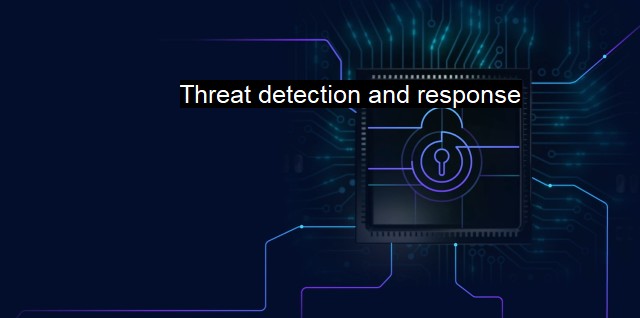What is Threat detection and response?
The Importance of Threat Detection and Response in Cybersecurity and the Antivirus Industry: A Comprehensive Guide
Threat detection and response is a critical aspect of cybersecurity that refers to the strategies, technologies, and practices implemented by organizations to identify, assess, and deal with cybersecurity threats. This typically involves the use of sophisticated software systems and robust procedures to constantly monitor an organization's digital ecosystem for any signs of potential cyber threats and respond to them effectively.Today, the increasing sophistication of cyberattacks requires more advanced measures in cybersecurity protocols. Each year, major data breaches emphasize the dire need for robust systems for threat detection and response. As part of a comprehensive security management strategy, threat detection and response programs stretch the capabilities of an antivirus solution beyond mere prevention. Rather, they operate to identify and manage threats swiftly and effectively, reducing the potential damage that could be inflicted on an organization’s digital infrastructure.
In the realm of cyber threats, detection often refers to the identification of unusual activity or behavior that is associated with the presence of malware or cyberattacks. This can involve intricate algorithms and complex computational analytics to identify patterns and anomalies within the system. Such detection software will scan the organization's networks, hardware, software, and databases for the footprints that cyber threats often leave behind. Once identified, these threats are tagged according to the severity of their potential impact.
The initial step in threat detection involves defining what types of actions can be considered a threat. This not only includes malware, such as viruses and ransomware, but it also involves the tracking of suspicious communications or the identification of prohibited hardware or software. Often, organizations implement an array of different detection measures, including the use of intrusion detection systems (IDS), security information and event management (SIEM) systems, and artificial intelligence-based recognition systems.
While detecting threats is critical, it is only part of the overall picture as the response component is just as necessary. The response to cyber threats involves quarantining, mitigating, eliminating, or reporting the detected threat. When a threat is identified, software protocols trigger pre-set responses, and this might mean severing network connections and shutting down certain functions to prevent the spread of the threat within the system. Depending on severity, responses might involve contacting relevant authorities or digital forensics teams to investigate further.
Threat responses also require detailed reporting and analysis of each identified threat. A comprehensive log is maintained of how these threats are detected and tackled, contributing to the iterative improvement in the organization's cybersecurity measures. Lessons learned from each incident help to refine threat detection algorithms and response protocols, building an increasingly resilient system.
Another vital aspect to consider in threat detection and response is the zero-day threats. These are threats that exploit a previously unknown vulnerability and catch security systems unawares. Hence, the detection and response systems must be capable of adaptive learning and swift action since these threats can potentially cause massive damage before traditional mitigation strategies can be employed.
Threat detection and response is a twofold process in cybersecurity. It involves measures for early identification of a cybersecurity threat, followed by swift and effective actions to contain the impact. In a world increasingly driven by digital systems, it is crucial to maintain vigilance against cybersecurity threats. Proper threat detection and response strategies can help organizations prevent serious damage to their virtual and physical assets, protect their intellectual property, and maintain their reputation in the digital space. Through ongoing improvements in threat detection technologies and robust response protocols, organizations can fortify their cybersecurity systems, ensuring resilience in the face of evermore sophisticated cyber threats.

Threat detection and response FAQs
What is threat detection and response in cybersecurity?
Threat detection and response in cybersecurity refer to the process of identifying and responding to potential cyber threats, such as viruses or malware, in order to protect a computer or network from being compromised.What are some common types of threats that antivirus software is designed to detect and respond to?
Antivirus software is designed to detect and respond to a wide range of threats, including viruses, malware, spyware, adware, and trojan horses. These threats can be spread through email, infected websites, or malicious software downloads.What are some best practices for effective threat detection and response in cybersecurity?
Some best practices for effective threat detection and response in cybersecurity include keeping antivirus software updated, regularly scanning your computer or network for potential threats, being cautious when opening email attachments or clicking on links from unknown sources, and using strong passwords and two-factor authentication to protect your accounts.How can a business benefit from implementing threat detection and response measures in their cybersecurity strategy?
By implementing effective threat detection and response measures, businesses can benefit by protecting their networks and sensitive data from potential cyber attacks, reducing the risk of financial loss due to data breaches, and maintaining the trust and confidence of their customers. Additionally, having a solid cybersecurity strategy in place can help businesses stay compliant with industry regulations and avoid costly fines for non-compliance.| | A | | | B | | | C | | | D | | | E | | | F | | | G | | | H | | | I | | | J | | | K | | | L | | | M | |
| | N | | | O | | | P | | | Q | | | R | | | S | | | T | | | U | | | V | | | W | | | X | | | Y | | | Z | |
| | 1 | | | 2 | | | 3 | | | 4 | | | 7 | | | 8 | | |||||||